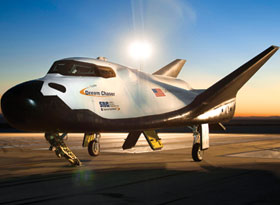

A world-class prime systems integrator and electronic systems provider known for its rapid, innovative, and agile technology solutions, Sierra Nevada Corporation (SNC) is currently developing a new space transportation system called the Dream Chaser. The ultimate aim is to construct a multi-mission-capable space utility vehicle, while accelerating the overall development process for this critical capability and keeping costs to a minimum. SNC’s Dream Chaser is able to do more than just transport crew and cargo to Low-Earth Orbit (LEO). The vehicle is uniquely able to operate as an independent science platform, logistics enabler, or orbital servicing vehicle with the ability to deploy, retrieve, repair, replace, refuel, or assemble items in space.
Dream Chaser provides the only reusable, human-rated, lifting-body spacecraft with a commercial runway landing capability, almost anywhere in the world – offering safe, affordable, flexible and reliable transportation to space. In developing the spacecraft, which will travel through space at speeds of up to 31 000 kilometres per hour, SNC is relying on Product Lifecycle Management (PLM) engineering software from Siemens. Use of this advanced engineering software tool has enabled a 20% reduction in the time required to work within this key Dream Chaser software program.
Sierra Nevada Corporation (SNC), the owner, developer and prime operator of the spacecraft, is working on the project in partnership with the 'Dream Team' consisting of world-class aerospace industry players, several universities and all 10 Centres of the US space agency NASA. The European Space Agency (ESA), the German Aerospace Centre (DLR) and the Japanese Aerospace Exploration Agency (JAXA) are also part of the Dream Team. SNC’s alliance with Dream Team Member Siemens PLM Software group will further help facilitate the international expansion of the Dream Team.
The strategy
Considering the gigantic costs inherent to the space industry, SNC came up with the strategy of building on existing experience to speed up the development process and keep costs down. Using the NASA HL-20 space plane as a basis for the Dream Chaser allowed SNC to take advantage of the benefits of the HL-20’s extensive development heritage encompassing both significant design refinements and exhaustive testing. NASA originally envisioned using the HL-20 as a crew rescue vehicle for the International Space Station (ISS), designed to land horizontally on conventional runways.
SNC married this space plane concept with the Atlas V rocket of the United Launch Alliance, whose development also benefited from the use of Siemens PLM Software technology. This combined strategy substantially reduced both the time and costs needed for Dream Chaser’s development. The outcome: a reusable, optionally-piloted spacecraft capable of transporting up to seven crew and cargo into LEO. The Dream Chaser is also able to launch and repair satellites, as well as, conduct free-flying microgravity experiments and dispose of space debris.
Shorter development times and cost savings
Shorter development periods and lower development costs are crucial to gaining a competitive advantage for companies working in the aerospace industry. Because these are the key to global success, SNC looked for only the most capable companies with the most advanced technologies to join the Dream Team. To allow the integrated team to work successfully on this complex product in a multi-CAD environment, SNC opted to use the engineering software tools within the Siemens PLM Software technology, which came with a successful track record in the development of the Atlas-V rocket and the Mars Rover Curiosity. Use of this engineering software also allowed for the integration of different computer-aided design (CAD) approaches. SNC opted to use the advanced engineering software within the Siemens PLM Software suite to assist with an integrated product design, development and production solution which enabled engineers to load and work with complex design data models up to 20 percent faster thus helping to reduce the development time needed for the program. John Curry, a former Space Shuttle flight director who now leads the Dream Chaser integrated systems design, development, test and evaluation program, firmly believes that simulation-led design also makes for enhanced safety. “We want to send people into space 10 times more safely at 1/20th of the previous cost,” he says. “And doing rapid prototyping via simulation first is a faster path.”
For more information contact Keshin Govender, Siemens Southern Africa, +27 (0)11 652 2412, [email protected], www.siemens.co.za
| Tel: | +27 11 652 2000 |
| Email: | [email protected] |
| www: | www.siemens.co.za |
| Articles: | More information and articles about Siemens South Africa |

© Technews Publishing (Pty) Ltd | All Rights Reserved